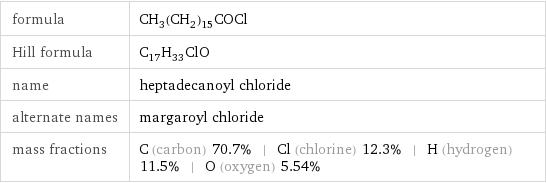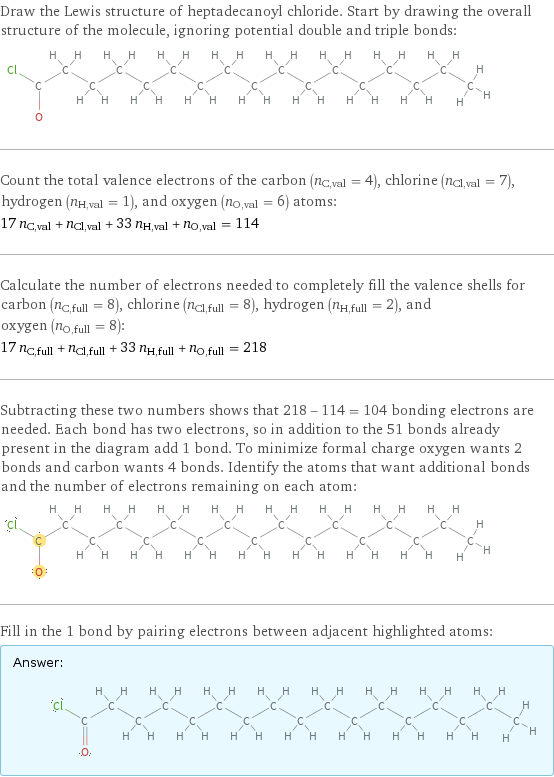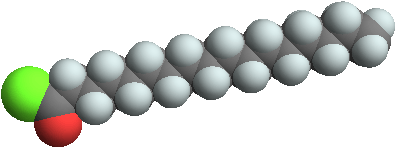Input interpretation

heptadecanoyl chloride
Chemical names and formulas

formula | CH_3(CH_2)_15COCl Hill formula | C_17H_33ClO name | heptadecanoyl chloride alternate names | margaroyl chloride mass fractions | C (carbon) 70.7% | Cl (chlorine) 12.3% | H (hydrogen) 11.5% | O (oxygen) 5.54%
Lewis structure

Draw the Lewis structure of heptadecanoyl chloride. Start by drawing the overall structure of the molecule, ignoring potential double and triple bonds: Count the total valence electrons of the carbon (n_C, val = 4), chlorine (n_Cl, val = 7), hydrogen (n_H, val = 1), and oxygen (n_O, val = 6) atoms: 17 n_C, val + n_Cl, val + 33 n_H, val + n_O, val = 114 Calculate the number of electrons needed to completely fill the valence shells for carbon (n_C, full = 8), chlorine (n_Cl, full = 8), hydrogen (n_H, full = 2), and oxygen (n_O, full = 8): 17 n_C, full + n_Cl, full + 33 n_H, full + n_O, full = 218 Subtracting these two numbers shows that 218 - 114 = 104 bonding electrons are needed. Each bond has two electrons, so in addition to the 51 bonds already present in the diagram add 1 bond. To minimize formal charge oxygen wants 2 bonds and carbon wants 4 bonds. Identify the atoms that want additional bonds and the number of electrons remaining on each atom: Fill in the 1 bond by pairing electrons between adjacent highlighted atoms: Answer: | |
3D structure

3D structure
Basic properties

molar mass | 288.9 g/mol phase | liquid (at STP) boiling point | 176 °C (measured at 533.2 Pa) density | 0.883 g/cm^3
Units

Liquid properties (at STP)

density | 0.883 g/cm^3 refractive index | 1.453
Units

Chemical identifiers

CAS number | 40480-10-2 Beilstein number | 1781006 PubChem CID number | 3516438 PubChem SID number | 24858494 SMILES identifier | CCCCCCCCCCCCCCCCC(=O)Cl InChI identifier | InChI=1/C17H33ClO/c1-2-3-4-5-6-7-8-9-10-11-12-13-14-15-16-17(18)19/h2-16H2, 1H3 MDL number | MFCD00000743
Safety properties

flash point | 110 °C